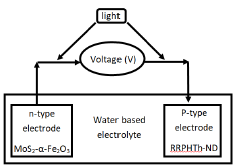Competitive Advantages
- Significantly higher efficiency
- Stable solid state cells
- Eliminates photo-corrosion
- Provides higher range of potential
Summary
Our inventors have designed a photoanode that uses alpha-hematite (α-Fe2O3), which has a much lower band gap than TiO2. The use of alpha-hematite is very attractive as it provides an efficiency of 16% when converting solar energy to hydrogen. In addition to low band gap, other benefits to using alpha-hematite are low cost, high chemical stability, nontoxicity, and abundance of materials. To improve the performance, the photoanode is doped with molybdenum metallic ions (using molybdenum disulfide, or MoS2) to promote electron transfer properties of the alpha hematite nanomaterial. Also, to provide highly efficient PEC conversion, the material “nano-hybrid regioregular polyhexylthiophene nanodiamond” (RRPHTh-ND) is used as a p-type electrode. This technology will benefit the renewable energy industry as it provides a more efficient and renewable method of producing hydrogen fuel from water using only the sun as an energy source.

Schematic of p-type RRPHTH-ND and n-type MoS2-α-Fe2O3 Electrodes in Water Based Electrolyte
Desired Partnerships
- License
- Sponsored Research
- Co-Development